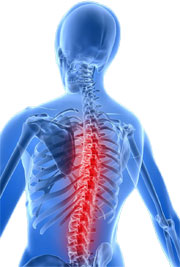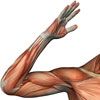- Introduction to spasticity
- What causes spasticity?
- Assessment of spasticity
- Management of spasticity
- Treatment of spasticity
Introduction to spasticity

- Muscle rigidity;
- Involuntary muscle contractions (spasms);
- Muscle dystonia;
- Associated reaction; and
- Muscle co-contraction.
Spasticity seems to have evolved as a protective symptom associated with neurological conditions that effect motor and cerebral functioning. Spasticity provides:
- Maintenance of vascular circulation;
- Maintenance of posture;
- Mobility assistance; and
- Preservation of muscle mass.
However, the greater the degree of spasticity, the greater the impairment of physical functionality, emotional health and social functioning, especially in children. It is for this reason that treatments for spasticity have been developed.
Specifically, spasticity can interfere with:
- Mobility;
- Sleep: Painful muscle cramps are an associated symptom;
- Wound healing;
- Comfort;
- Hygiene; and
- Positioning.
Spasticity also causes indirect manifestations, including:
- Stiff joints;
- Pain;
- Musculoskeletal abnormalities;
- Joint subluxation (carpal bones);
- Clubfoot;
- Hyperextension;
- Contracture of the hip joint;
- Curled toes and fingers;
- Strain on postural muscles;
- Skin lesions (from nails); and
- Ulcers.
What causes spasticity?

- Congenital diseases such as cerebral palsy (CP): Spastic CP is the most common type of the disease, affecting up to 80% of people with the condition. Spastic CP is associated with dysfunctioning descending motor systems, leading to muscle weakness and loss of agility.
- Progressive diseases such as multiple sclerosis (MS): In advanced stages of MS, the damage inflicted on the upper motor neurons can cause spasticity.
- Static events such as a stroke: Stroke can inflict damage on upper motor neurons, and as a result spasticity can occur after the event.
- Trauma: Spasticity can be acquired through brain injury or after damage to the spinal cord.
- Non-neurological disease: Spasticity can also be associated with non-neurological diseases such as cancer.
Assessment of spasticity
Spasticity is experienced in different degrees, muscles and severity by different people, so it is important that each case of spasticity is assessed individually. Observation and examination during movement is the primary means of assessing and identifying patterns of movement and limb posture.
While a doctor usually has a fair idea of the severity of the spasticity through observation alone, it is very important that an understanding of how the spasticity is affecting the individual be gained, and this information is best provided by the person experiencing the symptoms, or by the carers. This input will help the healthcare team to develop a management plan that will best suit their individual symptoms. The doctor may ask questions like:
- How you are coping both physically and mentally with your condition?
- Are you experiencing pain or discomfort?
- Are you having difficulties sleeping or performing day to day activities?
- Are you aware of any increased muscle stiffness?
- Are there any problems with the activities of daily living (e.g. bathing, toileting, dressing and grooming)?
Once the specific areas of impairment are determined, an appropriate treatment plan can be developed.
Spasticity was once thought to be reflex responses to passive muscle movement (when the muscle is moved by an external force, such as a therapist). However, testing of reflex responses has replaced this original theory with the concept that spasticity is characterised by muscle resistance to active muscle movement (when the muscle is voluntarily moved). The more intense the active movements, the greater the muscle tone resulting in muscle hyperexcitability, and the greater the level of spasticity.
Modified Ashworth Scale
Spasticity is most often measured by assessing muscle resistance to passive movements using the Modified Ashworth Scale (MAS). The MAS is conducted while lying down face up, in order to lower tension in the body as much as possible. A therapist quickly moves the spastic limb through the joint’s range of motion (ROM), from the maximum joint extension to the maximum flexion. The limb needs to be moved at the same pace as a limb without spasticity would move, which is a “free-fall”, moving as fast as gravity will allow. The resistance to the movement is then indicated using the MAS. The scores are defined as follows:
Modified Ashworth Scale (MAS) scores
| Score | Definition |
|---|---|
| 0 | No resistance. |
| 1 | Slight resistance, shown by a catch and release or by minimal resistance at the end of the ROM. |
| 2 | Slight resistance, shown by a catch, followed by minimal resistance in the rest (less than half) of the ROM. |
| 3 | Greater resistance through most of the ROM, but still easily moved. |
| 4 | Substantial resistance, and difficult to move. |
| 5 | Rigidity in the muscle. |
As spasticity is a multifaceted condition, the measurements to assess its severity are also varied.
Tardieu Scale
Another clinical measure that is favoured by some therapists to assess spasticity is the Tardieu Scale.
The Tardieu Scale is conducted while lying down face up. Like in the MAS, the therapist will move the limb through the range of motion, but instead of only assessing one speed, the muscle response is tested at three different speeds, or velocities. The three different velocities used are named V1–V3. The response to the three different velocities, the X score, is then measured. If the muscle resists the push by the therapist at a certain point (like a muscle “catching”), the angle of the joint at that point is measured and recorded as the Y value.
The velocity specifics are as follows:
- V1: As slow as possible;
- V2: Movement of the limb equal to the pull of gravity; and
- V3: As fast as possible.
The X scores are very similar to the MAS:
- 0: No resistance;
- 1: Slight resistance but no clear resistance point;
- 2: Clear resistance point at an identified angle, followed by a release;
- 3: A stronger resistance point that catches for less than 10 seconds before release;
- 4: A very strong resistance at a precise angle maintained for greater than 10 seconds.
The Tardieu score is then expressed as X/Y at each V value.
Laboratory tests
There are many laboratory assessments used to determine different aspects of the condition, including:
- Using instruments such as a dynamometer to measure the relationship between joint angles and active limb movements and to determine flexibility of the affected muscles;
-
Measuring muscle reflexes in response to mild electrical stimulation, a procedure known as electrophysiological reflex testing; and
- Measuring and recording muscle activation, a process known as electromyography.
Management of spasticity

For many people, spasticity is a protective mechanism and is therefore covering an underlying weakness. By removing the stiffness, the weakness is exposed, which may be more uncomfortable and difficult to manage than the spasticity itself. Sometimes a little rigidity will aid in certain daily weight-bearing and mobility requirements.
Treatment of spasticity
Muscle weakness, muscle overactivity and soft-tissue contracture are the major causes of impairment in spastic limbs, and are therefore the focus points for treatment.
The first step in treating spasticity is to develop the treatment program and define realistic goals. The program will be developed with a neurologist or a rehabilitation specialist. After the neurologist/rehabilitation specialist has assessed the spasticity and helped to clarify treatment aims, an individualised plan is developed, taking into account the specific degree and severity of the spasticity experienced. The probable outcomes of the treatment plan will be discussed.
Treatment for spasticity must begin with physical intervention, usually by a physiotherapist or occupational therapist, before any pharmacological options are introduced. Not all people will tolerate pharmaceutical intervention and some types of spasticity will not respond well, if at all. If medication is determined to be a viable option, then the treatment plan will still include a mixture of physical interventions.
The treatment options for spasticity are diverse and, as such, involve a team of people who each bring separate specialities and focus to the rehabilitation program. A neurologist or rehabilitation physician is needed to coordinate the team, which can include general practitioners, nurses, physiotherapists, occupational therapists and neurosurgeons, as well as consultant physicians and specialists. Members of the support base, including family, friends, carers and nursing staff, also play an important role in treatment.
Treatment without medication can range from fairly mild physical interventions to quite invasive surgery that should only be used in the most unmanageable cases.
The first line treatments for spasticity include:
- Avoiding stimuli that may trigger muscle spasticity and further rigidity. These can include urinary tract infections, bladder distention, kidney stones (urolithiasis), bowel impaction, bed sores (decubitus ulcers) and osteomyelitis. If worse than usual spastic symptoms are being experienced, the first action is to rule out these stimuli and treat them if they are present;
- Physical therapies, such as stretching out the muscles, can be efficacious in relieving some of the stiffness and rigidity associated with spasticity. In order to maintain the stretches for a longer period, limb casting can be used;
- Exercise;
- Applying heat or cold packs or cooler sprays is a simple physical therapy that may cause some relief;
- Occupational therapy;
- Bracing and splinting the muscles helps stop spasms, and reduces muscle damage as a result; and
- Ultrasound therapy.
In more severe cases when the spasticity is causing major discomfort and rigidity is severely affecting daily routine, the following options can be considered:
- Short-wave diathermy is a treatment designed to increase blood flow in the problem area in order to reduce pain and promote healing;
- A form of muscle–tendon surgery involving the lengthening and release of the muscle–tendon connections; or
- Procedures to destroy the nerves, such as neurectomy, myeltomy and rhizotomy, are the absolute last line therapy.
Not all people with spasticity will require pharmacological treatment. The underlying cause and the severity of the spasticity will dictate whether or not the benefits of the treatment will be effective. In situations where the spasticity is causing pain and discomfort, it will be treated pharmacologically.
When the spasticity is acquired through brain or spinal injury/trauma, there is evidence to suggest that timely initiation of treatment will reduce the risk of secondary malformation in muscles and tissue, degeneration of muscle activity and impairments in muscle functioning. Therefore it is imperative you self-monitor your symptoms after a traumatic brain event, such as stroke, and have regular checkups with your doctor to ensure that any spasticity that develops is managed as soon as possible.
Botulinum toxin (BoNT; Botox) is a naturally produced protein that, when administered intramuscularly, can relieve spasticity by blocking acetylcholine release at the neuromuscular junction. BoNT is considered to be the treatment that most effectively reduces spasticity. It combats the major impairment associated with function reduction in spastic muscles by:
- Reducing spastic co-contraction;
- Decreasing spastic dystonia; and
- Helping to ease the stretching and lengthening of the muscle.
Botox side effects can develop when the toxin spreads. It is important to seek medical attention immediately if any difficulties in speech, breathing or swallowing occur.
Medications with spasticity reduction as a primary indication include:
- Oral or intrathecal baclofen (e.g. Lioresal, Baclohexal, GenRX Baclofen, Clofen);and
- Dantrolene (Dantrium).
Other effective agents used to treat spasticity, although not primarily indicated for it, include:
- Gabapentin (e.g. Neurontin, Gabatine, Gabaran, Nupentin, GenRX Gabapentin, Pendine);
- Pregabalin (Lyrica)
- Tiagabine (Gabitril);
- Diazepam (e.g. Diazepam Elixir, Ducene);
- Clonidine (Catapres); and
- Tizanidine.
It is sometimes necessary for people to use alternative administration methods if oral administration is difficult, and to ensure the medication is fully absorbed. For example, intrathecal injections of baclofen (Lioresal Intrathecal) or dantolene (Dantrium Powder for Injection) be used instead of oral medication.
Kindly reviewed by:
Dr Roxana Heriseanu
MBBS FAFRM RACP
Staff Specialist at the Royal Rehabilitation Centre, Sydney; and Editorial Advisory Board Member of the Virtual Neuro Centre.
More information
 |
For more information on neurological disorders that affect movement, and their treatments, see Neurological Rehabilitation and Movement Disorders. |
 |
For more information on multiple sclerosis, a disease associated with this symptom, see Multiple Sclerosis (MS). |
References
- Sheean DG. Is spasticity painful? Eur J Neurol. 2009; 16(2): 157-8
- Hobart JC, Riazi A, Thompson AJ, Styles IM, Ingram W, Vickery PJ, et al. Getting the measure of spasticity in multiple sclerosis: The Multiple Sclerosis Spasticity Scale (MSSS-88). Brain. 2006; 129(Pt 1): 224-34.
- Saulino M, Jacons BW. The pharmacological management of spasticity. J Neurosci Nurs. 2006; 38(6): 456-9.
- Simpson DM, Gracies JM, Graham HK, Miyasaki JM, Naumann M, Russman B, et al. Assessment: Botulinum neurotoxin for the treatment of spasticity (an evidence-based review): Report of the Therapeutics and Technology Assessment Subcommittee of the American Academy of Neurology. Neurology. 2008; 70(19): 1691-8.
- Honaga K, Masakado Y, Oki T, Hirabara Y, Fujiwara T, Ota T, et al. Associated reaction and spasticity among patients with stroke. Am J Phys Med Rehabil. 2007; 86(8): 656-61.
- Pierce SR, Barbe MF, Barr AE, Shewokis PA, Lauer RT. Roles of reflex activity and co-contraction during assessments of spasticity of the knee flexor and knee extensor muscles in children with cerebral palsy and different functional levels. Phys Ther. 2008; 88(10): 1124-34.
- Gordon LM, Keller JL, Stashinko EE, Hoon AH, Bastian AJ. Can spasticity and dystonia be independently measured in cerebral palsy? Pediatr Neurol. 2006; 35(6): 375-81.
- Wissel J, Ward AB, Erztgaard P, Bensmail D, Hecht MJ, Lejeune TM, et al. European consensus table on the use of botulinium toxin type in adult spasticity. J Rehabil Med. 2009; 41(1): 13-25.
- Ward AB. Spasticity treatment with botulinium toxins. J Neural Transm. 2008; 115: 607-16.
- Levine P. Testing spasticity: The Modified Ashworth Scale [online]. Advance for Physical Therapy and Rehab Medicine; 2 June 2000 [cited 10 January 2010]. Available from URL: http://physical-therapy.advanceweb.com/ Article/ Testing-Spasticity-The-Modified-Ashworth-Scale.aspx
- Wusthoff CJ, Shellhaas RA, Licht DJ. Management of common neurologic symptoms in pediatric palliative care: Seizures, agitation, and spasticity. Pediatr Clin North Am. 2007; 54(5): 709-33.
- Lundström E, Terént A, Borg J. Prevalence of disabling spasticity 1 year after first-ever stroke. Eur J Neurol. 2008; 15(6): 533-9.
- Patrick E, Ada L. The Tardieu Scale differentiates contracture from spasticity whereas the Ashworth Scale is confounded by it. Clin Rehabil. 2006; 20(2): 173-82.
- Movement Disorder Virtual University. Tardieu rating scale [online]. We Move; 11 March 2006 [cited 21 February 2010]. Available from URL: www.mdvu.org/library/ratingscales/spasticity/Tardieu_Scale.pdf
- Allergan Australia Pty Ltd. Product Information: Botox. Gordon, NSW: Allergan Australia Pty Ltd; 6 August 2009.
- Patel AT. Brain Trauma: Stroke: Early diagnosis of post-stroke spasticity and treatment options. [online] Touch Briefings 2009: 47-51. Touch Neurology; 2009 [cited 30 March 2010]. Available from URL: http://www.touchneurology.com/files/article_pdfs/patel_0.pdf
Drugs used in the treatment of spasticity:
- Baclohexal (Baclofen)
- Clofen (Baclofen)
- Dantrium Capsules (Dantrolene sodium)
- Dantrium Powder for Injection (Dantrolene sodium)
- GenRx Baclofen (Baclofen)
- Lioresal (Baclofen)
- Lioresal Intrathecal (Baclofen)
- Botox (Botulinum toxin type A)
- Dysport (Botulinum toxin type A)
- Diazepam Injection (DBL) (Diazepam)
- Ducene (Diazepam)
- Gabitril (Tiagabine hydrochloride)
- GenRx Gabapentin (Gabapentin)
- Neurontin (Gabapentin)
- Pendine (Gabapentin)
- Catapres 100 (Clonidine hydrochloride)
- Nupentin (Gabapentin)
- Lyrica (Pregabalin)
All content and media on the HealthEngine Blog is created and published online for informational purposes only. It is not intended to be a substitute for professional medical advice and should not be relied on as health or personal advice. Always seek the guidance of your doctor or other qualified health professional with any questions you may have regarding your health or a medical condition. Never disregard the advice of a medical professional, or delay in seeking it because of something you have read on this Website. If you think you may have a medical emergency, call your doctor, go to the nearest hospital emergency department, or call the emergency services immediately.








